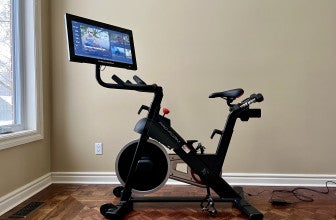
Different Kinds of Bicycles
A number of different types of bicycles are available, each designed for the way a cyclist will ride the bike. Road bicycles have a special design that makes them ideal for riding on smooth surfaces such as pavement. Thin tires, lightweight frames, and drop handlebars are features that make these bikes fast. Touring bicycles are similar to road bikes, but these bicycles have extra features that provide more comfort for the rider over longer distances. The frame enables the rider to sit more upright, and a lower gear range makes it easier to climb steep hills with a load. Mountain bikes have a rugged design that makes them ideal for off-road riding. These bikes might have upright or flat handlebars, and they also feature a shock-absorbing suspension for bumpy trails. Hybrid bicycles combine features of road and mountain bicycles. These bikes are heavier than standard road bicycles, but they usually have upright handlebars for comfort. Riders can ride these cycles on either smooth or unpaved surfaces. BMX bicycles appeal to children thanks to their small size and other features that enable stunts and tricks.
- Choosing a Bike (PDF)
- Choosing the Right Bike (PDF)
- The Evolution of the Bicycle (PDF)
- Choosing the Right Bicycle (PDF)
- Buying a Mountain Bike (PDF)
- Bicycle Types: How to Pick the Best Bike for You
- Bicycles: How to Choose the Best Bike
- Types of Bikes
Cycling for Fitness
Riding a bicycle for fitness can be both effective and enjoyable. Riding a bicycle builds endurance due to the sustained effort involved with riding for miles. While riding, you will usually encounter a variety of inclines and declines, which gives the opportunity for interval training at higher and lower intensity levels. Bicycling builds muscles, increases cardiovascular fitness, burns calories, and can even increase brain power thanks to increased oxygen and blood flow to the brain.
- How Do Your Muscles Work?
- 30-Mile Cycle Beginner Training Plan (PDF)
- Bike Training Guide (PDF)
- Advice for Starting a Bicycling Exercise Routine (PDF)
- Precision Cycling (PDF)
- The Relevance of Winds in Bicycling (PDF)
- 12 Tips for Better Cycling
Cycling for Transportation
Finding time for exercise can be challenging, but some people choose to use cycling for transportation, which combines physical activity with getting where you need to go. When you opt to ride a bike to work or school, you give your body the exercise it needs, you get fresh air, and you benefit the environment because you are not using a mode of transportation that uses fossil fuels. Many cities have implemented commuter bike trails to give cyclists safe and efficient routes for biking.
- Bike Basics (PDF)
- Bike to Work (PDF)
- Bicycle Commuter’s Handbook (PDF)
- How to Increase Bicycling for Daily Travel (PDF)
- How to Start Road Cycling (PDF)
- Bicycle Commuter Guide (PDF)
- Evaluating Active Transport Benefits and Costs (PDF)
Safety Tips for Cycling
While enjoyable and effective as a type of exercise, bicycling demands prudence to ensure safety. A cyclist must maintain the bicycle carefully to ensure that every component, such as brakes and gears, works correctly. Failure to maintain a bike could lead to mishaps. Bicycle safety also involves wearing a helmet to protect the cyclist’s head in the event of an accident. Head impacts are a significant cause of serious injury and even death after a bike accident. Installing a horn, a rearview mirror, and lights in the front and back of the bike also improves safety. When riding on the street, cyclists must operate as motorists, biking on the far right side of the road, using signals, and obeying traffic signals.
- Safe Cycling Guide (PDF)
- Cycling Tips (PDF)
- Smart Cycling (PDF)
- Bicycle Safety
- Developing Bicycle Handling Skills and Safe Habits (PDF)
- Bicycle Safety (PDF)
- Guide to Bicycle Safety (PDF)
- Bicycling Safety Fact Sheet (PDF)
Cycling for Recreation
People can ride bicycles recreationally in a variety of ways. Some people join a cycling or touring club when they wish to ride recreationally. These clubs organize group rides between various points, and members can ride with other cyclists. A mountain biking club might organize rides on unpaved bike trails. Joining a cycling club can be an excellent way to meet other bikers and learn about new places to ride.
- Let’s Go Biking! (PDF)
- 250 Best Cycling Tips (PDF)
- Getting Started With Cycling (PDF)
- 10 Myths About Women and Cycling (PDF)
- Riding Your Bicycle Is Fun and Healthy, Too! (PDF)
- Bicycling Facts: Reasons to Ride
- The Practical Side of Cycling
Cycling for Sport
A number of opportunities exist for people who wish to cycle for sport. Competitive cycle racing involves cycling on a course to compete with other racers. Race courses vary in style and length. Short races on paved courses are one possibility, or the races could be lengthy or off-road. BMX racing involves racing BMX bikes over tracks that feature bumps, jumps, and berms. The racers must make a specific number of laps to complete the course.
- Competitive Cycling Skills (PDF)
- The Physiology and Technique of Hard Riding
- Track Cycling: An Introduction (PDF)
- Race Across America Cycling Challenge Endurance Racing Primer (PDF)
- A Guide to BMX Racing (PDF)
- Strength-Training Considerations for the Bicycle Motocross Athlete (PDF)
- A Beginner’s Guide to Racing (PDF)




